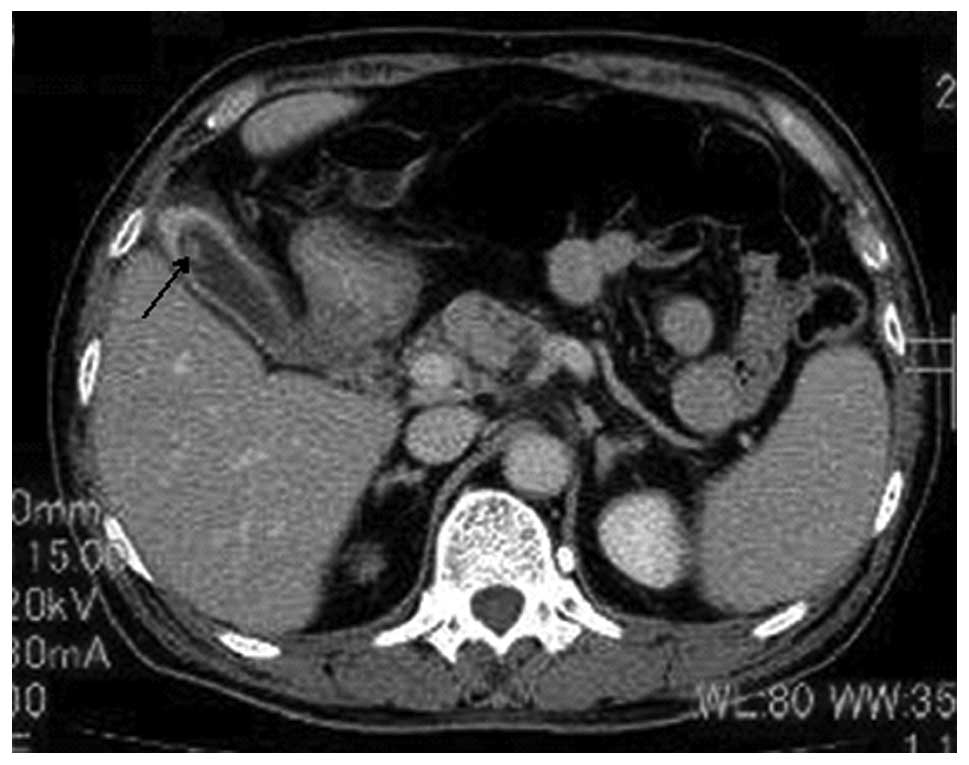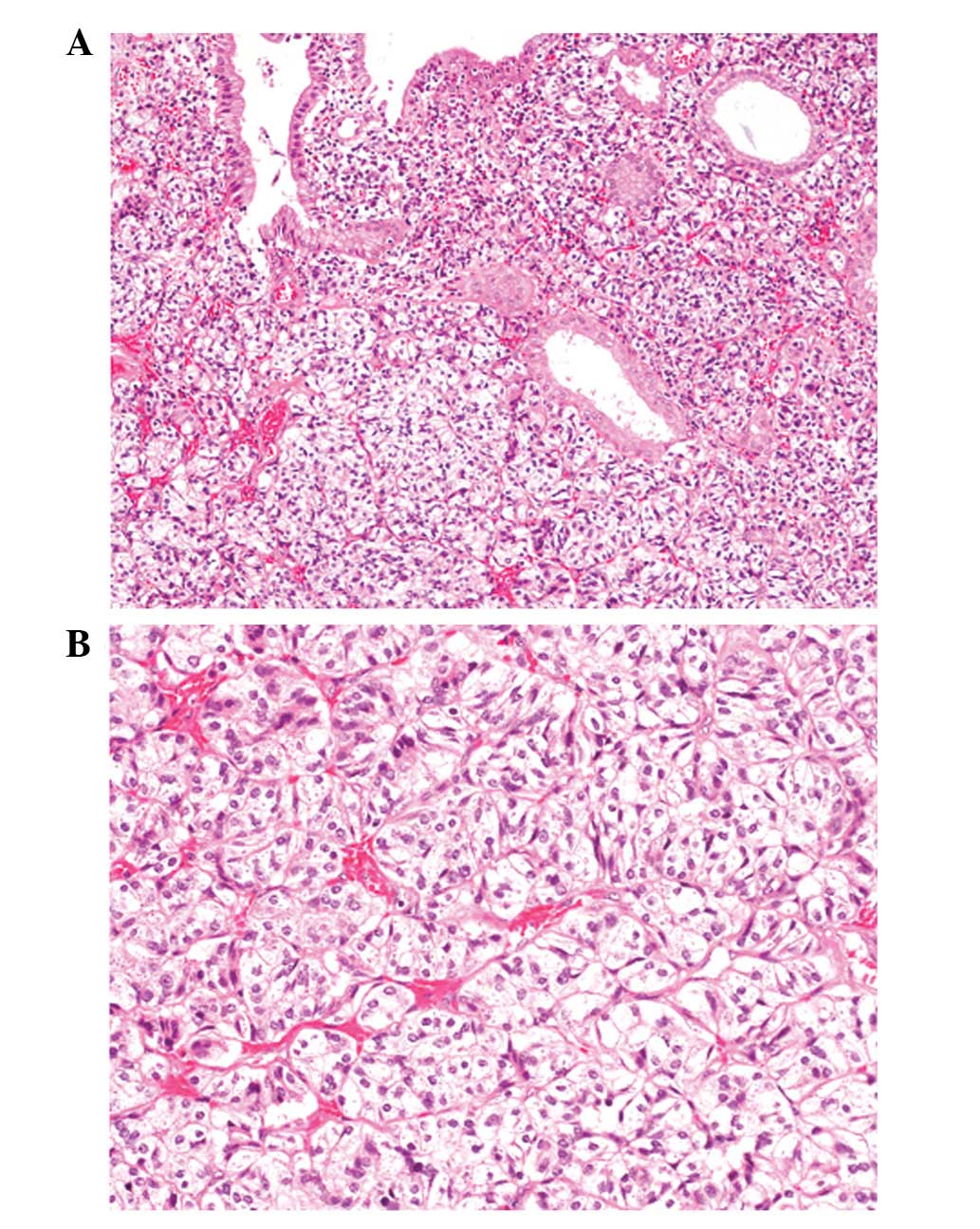Clear cell neuroendocrine tumor G1 of the gallbladder without von Hippel-Lindau disease
- Authors:
- Published online on: September 6, 2012 https://doi.org/10.3892/ol.2012.899
- Pages: 1174-1176
Abstract
Introduction
Neuroendocrine tumors (NETs) are relatively rare (1). Previous World Health Organization Classification groups NETs into G1 (referred to synonymously as ‘carcinoid tumor’), G2 and G3 (neuroendocrine carcinoma) (2). Primary NETs of the gallbladder comprise only 0.5% of all NETs arising from any tissue or organ and less than 2% of all cases of gallbladder cancer (3). Moreover, the majority of primary gallbladder NETs are G3, making a primary NET G1 in this organ extremely rare (3,4).
The cytoplasm of NET cells is usually eosinophilic to amphophilic; however, in rare cases, the cytoplasm appears clear and is referred to as ‘clear cell variant’. This variant has been described as a distinctive manifestation of von Hippel-Lindau disease (VHL) (5) and there are few reports of clear cell NET in non-VHL patients (6). Only two cases of primary gallbladder clear cell NET G1 have been reported in the English-language literature: one was associated with VHL (7) and the other was not (8). This report describes a second case of clear cell NET G1 of the gallbladder in a patient without VHL and discusses the clinicopathological features of this extremely rare lesion.
Patient and methods
Patient
A 71-year-old Japanese male without past or family history of VHL, presented with sudden abdominal pain. Computed tomography demonstrated stones in the common bile duct and gallbladder, as well as a 9-mm polypoid lesion in the fundus of the gallbladder (Fig. 1). No tumorous lesions were detected in the pancreas or kidneys and no symptoms of carcinoid syndrome were noted. Laparoscopic cholecystectomy was performed. The study was approved by the ethics committee of Shiga University of Medical Science, Shiga, Japan. Written informed patient consent was obtained from the patient.
Materials and methods
Formalin-fixed, paraffin-embedded tissue blocks of the resected specimen of the gallbladder were cut into 3-μm thick sections, deparaffinized and rehydrated. Each section was stained with hematoxylin and eosin and then used for immunostaining. Immunohistochemical analyses were performed using an autostainer (XT system Benchmark, Ventana Medical System, Tucson, AZ, USA) according to the manufacturer’s instructions. The following primary antibodies were used: mouse monoclonal anti-α-inhibin (R1, Thermo Fisher Scientific, Waltham, MA, USA), mouse monoclonal anti-α-internexin (2E3, Lab Vision, Waltham, MA, USA), mouse monoclonal anti-chromogranin A (DAK-A3), rabbit polyclonal anti-gastrin, rabbit polyclonal anti-glucagon (all purchased from Dako Cytomation, Glostrup, Denmark), mouse monoclonal anti-insulin (Z006, Nichirei Bioscience, Tokyo, Japan), mouse monoclonal anti-Ki-67 (MM1, Novocastra Laboratories, Ltd., Newcastle-upon-Tyne, UK), mouse monoclonal anti-peripherin (PJM50, Novocastra), rabbit polyclonal anti-pancreatic polypeptide (Lab Vision), rabbit polyclonal anti-S-100 protein (Nichirei), mouse monoclonal anti-serotonin (5HT-H209, Dako), rabbit polyclonal anti-somatostatin (Dako) and mouse monoclonal anti-synaptophysin (27G12, Novocastra).
Results
Macroscopically, we observed three small gallbladder stones in the lumen, a mild thickening in the wall of the gallbladder and a 9-mm yellowish polypoid lesion in the fundus.
Histopathologically, the polypoid lesion was comprised of nests or trabecular growths of cuboidal cells. These cells had rich clear cytoplasm and small round nuclei with inconspicuous nucleoli separated by delicate capillary networks (Fig. 2A and B). Mitotic figures were rarely observed (<1/20 high power fields). The neoplastic growth of clear cells was restricted to the lamina propria of the polypoid lesion. The surface of the polyp was composed of biliary epithelium without atypia and non-neoplastic biliary glands were entrapped among the nests of clear cells (Fig. 2B). Neither vascular nor lymphatic invasion were present. Chronic cholecystitis with Rokitansky-Aschoff sinuses, as well as gastric metaplasia and adenomyosis, was observed in the surrounding gallbladder tissue, however, intestinal metaplasia was not noted.
Immunohistochemical analyses revealed diffuse expression of synaptophysin and chromogranin A in the neoplastic clear cells (Fig. 3), but no S-100 protein or α-inhibin. While somatostatin was focally expressed in clear cells, we did not detect any immunoreactivity for gastrin, glucagon, insulin, serotonin or pancreatic polypeptide. The Ki-67 labeling index was 0.8%. The expression of peripherin and α-internexin was not observed in the neoplastic cells. In addition, we detected focal expression of chromogranin A and synaptophysin in the non-neoplastic glands with gastric metaplasia (Fig. 3, inset).
According to the histopathological and immunohistochemical findings of the present study, diagnosis of clear cell NET G1 of the gallbladder was made.
Discussion
In the present study we describe the second reported case of clear cell NET G1 of the gallbladder in a patient without VHL. Table I summarizes the clinicopathological features of all three reported cases of clear cell NET G1 of the gallbladder (7,8). All patients were male and middle-aged to elderly (average age, 57.7 years; range, 38–71). Lesions were located in the neck in the two previous cases and in the fundus in the present study. Only one previous case was associated with VHL and the others, including the present case, were not associated with VHL. Cases of clear cell NET G1 of the gallbladder all occurred in males, contrasting with general cases of clear cell NET G1 of the pancreas and gallbladder NETs, which are more prevalent in females (60–70%) (3,5).
While normal gallbladder mucosa has no neuroendocrine cells, gallbladder mucosa with gastric and/or intestinal metaplasia contains neuroendocrine cells that express peptides, including gastrin, somatostatin, serotonin and glucagon (9–11). Moreover, the majority of previous reports of NETs of the gallbladder describe cases with gallbladder stones and cholecystitis (3,12). In one study, intestinal metaplasia was found in 11.7% of gallbladders with cholelithiasis and 83.3% also contained chromogranin A-positive neuroendocrine cells (11). These data suggest that the occurrence of gallbladder NETs is associated with chronic cholecystitis induced by gallbladder stones and that this association may explain the predilection for gallbladder NETs in females.
Cholecystitis was also evident in two cases of clear cell NET G1 of the gallbladder. While gastric metaplasia with chromogranin A-positive neuroendocrine cells was observed in the present case, it is unclear whether neuroendocrine cells were present in gallbladder mucosa in the case reported by Konishi et al (8). Although reported cases are extremely limited, gallbladder stones were also found in two of three clear cell NET G1 cases reviewed here (the case without gallbladder stone was VHL-related; Table I). Therefore, chronic cholecystitis induced by gallbladder stones may be associated with clear cell NET G1 (particularly non-VHL-related cases) as well as conventional gallbladder NETs. It is plausible that gallbladder NETs, including the clear cell variant, may originate from neuroendocrine cells of intestinal and/or gastric metaplastic mucosa induced by chronic cholecystitis (3).
α-inhibin is expressed in NET G1 of the gallbladder and pancreas associated with VHL. However, classical NET G1 of the gallbladder and non-VHL associated NET of the pancreas do not exhibit positive immunoreactivity for this marker and α-inhibin has subsequently been reported as a marker for VHL (7). In the present case of clear cell NET G1, consistent with the previous report without VHL (8), no α-inhibin was observed in the tumor cells. These results suggest that surveillance of α-inhibin expression may be a useful criterion for distinguishing whether clear cell NET is associated with VHL.
We previously characterized the expression of neuronal intermediate filament proteins in NETs of various organs (13,14). While peripherin (a type III intermediate filament protein expressed in normal peripheral nerves) is expressed in all NET G1 of the rectum, its expression incidence is low in NET G2 of the rectum (13). By contrast, expression of α-internexin (a type IV intermediate filament protein normally found in the central nervous system) is observed in all NET G1 of the appendix and approximately half of rectal NET G1. All appendiceal NET G1 cases co-express peripherin and α-internexin (14). Since neither peripherin nor α-internexin expression was observed in this case of clear cell NET G1 of the gallbladder, it appears that intermediate filament protein expression varies with NET origin.
In conclusion, while clear cell NET is a rare histopathological variant often described as a distinct manifestation of VHL, we report a rare case of clear cell NET G1 of the gallbladder without VHL. Surveillance immunohistochemistry for α-inhibin may prove useful as a determinant of whether a clear cell NET is VHL-associated or not.












